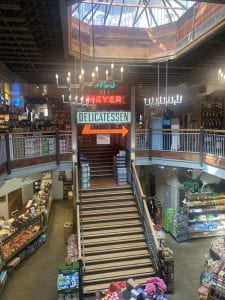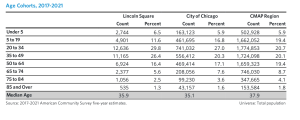Finding Chicago: The Lost and Found of Lincoln Square Community
Author: Yukun Chen
Program of Study: Master of Arts Program in the Social Sciences (MAPSS), Division of the Social Sciences (SSD)

The “A Touch of Europe: Memories of Germany” mural. (Photo taken by author)
Right after getting off the train at the Western station, a giant mural stood in front of me. Unlike most of the murals I’ve seen in the city, which usually give a sense of street culture, this mural looked like an art piece that I would expect to see in an art museum. A beautiful landscape was displayed on the red-brick wall. The warm and soft colors implied a peaceful lifestyle, and the faded paint indicated a length of history. This whopping piece of art has a name that is as historic and nostalgic as it appears: A Touch of Europe: Memories of Germany, and is also known as the “Lincoln Square Mural”. This mural was originally created in memory of the German heritage of this neighborhood, which is reflected in the mural as a series of German landmarks, such as the Rhine River, Bavarian villages, and the Alps. While the mural is of historical significance and represents the heritage of the neighborhood, the residents of German ancestry in Lincoln Square have largely decreased and have been replaced by younger and wealthier populations. This gentrification of the neighborhood has progressed to a degree that the proposal of restoration of this important artwork has encountered several obstacles, with the main focus being whether the mural was worth saving when many current residents are not German descendants (Huebner, 2020). The situation of this mural raises a question: what does it mean to be a community?

Our group in front of the arch. (Photo taken by author)
After bidding farewell to the mural, we walked towards the north. At the intersection of West Leland Avenue and North Lincoln Avenue, there was a bronze-like arch on which was written “LINCOLN SQUARE”, which signaled the entry of the most vibrant and iconic area in this neighborhood, North Lincoln Avenue, which we called “the main street”.
“You should move here after graduation.” An old gentleman walking his dog on North Lincoln Avenue suggested. “It’s a nice neighborhood.” As a resident here at Lincoln Square, his words sounded convincing. Looking at the beautiful fountains and statues, athletic but at the same time laid-back pedestrians, and seemingly randomly but actually elegantly allocated plants, I started to grow an inclination to agree with his idea. The gentleman’s wife later joined us and recommended that we visit the “nice boutique grocery store” right across the street, Gene’s Sausage Shop and Delicatessen.

Gene’s entrance. (Photo taken by author)

Inside Gene’s. (Photo taken by author)
As I walked into the store, it welcomed me with a harmonious brown-toned entrance full of cozy yet textured decorations. The interior of the store inherited the cozy yet chic design style featuring wooden stairs, neon signs, and candle-shaped chandeliers. According to its website, Gene’s was originally a sausage specialist. Yet, now this boutique store even has a rooftop full of mini birdcages and fresh flowers that serves beers and sausages. Coming down from the rooftop, I found the most expensive eggs I’ve seen in Chicago. Gene’s had a whole collection of eggs with different prices, ranging from $3.99 to $9.99 per dozen, with only three out of seven options below $6.99. The highest price of a dozen eggs I’ve seen previously was $6.49 for “pasture raised organic large brown eggs” at Trader Joe’s in Hyde Park, which could only be ranked the fifth highest price out of eight (the $6.49 option included) here at Gene’s. At this boutique store, titles of the eggs were expressed differently and not as specific, usually just brand names with or without the producing process, such as the $9.99 “Vital Farm Eggs” and the $7.99 “Happy Eggs Free Range”. To me, the briefness of the names on the tags indicates a cultivated knowledge of perceiving different egg qualities through simply brand names, an ability and privilege acquired by frequently shopping at Gene’s or grocery stores at the same level.

Rooftop at Gene’s. (Photo taken by author)

Eggs at Gene’s. (Photo taken by author)
Although I loved shopping and staying at Gene’s, I can’t help recognizing that the bourgeois phenomenon at the store echoes the gentrification of the population in this neighborhood pointed out by Huebner, who wrote an insightful article about the Lincoln Square community (Huebner, 2020). Moreover, to back up Huebner’s point, Voorhees’ study also indicated that Lincoln Square had been gentrifying in the last few decades, since it went through a decline from 1970 to 1990, and experienced a growth from 1990 to 2010 (Voorhees, 2014). Furthermore, data showed that over 70% of households are made up of 2 persons or less, with more than 55% of residents falling between 20 to 50 years old, specifically, almost 30% are between 20 and 35 years old, indicating a younger composition of residents in this neighborhood (Chicago Metropolitan Agency for Planning, 2023). As the residents become younger and more affluent, the purchasing power of consumers in this area increases, and thus brings up the prices of products sold in this neighborhood. In addition to the rise of the price, younger customers also foster a more trendy taste in the neighborhood. Thus, while some traditional stores like Gene’s still exist to signify a German root, more businesses like fitness centers, clubs, and contemporary American cuisine restaurants are opening up to target younger populations (Huebner, 2020). Clean, safe, delicate, bourgeois… These are all the words I would use to describe Lincoln Square. Being here in Lincoln Square feels like suddenly transferring to a nice little town in central Europe, where every shop is small but delicate, and people walk their dogs on the street with ease. Sunshine, boutique shopping, dog walking… These are all great and even luxurious things to enjoy, but how many roots are still left for the community?

Household Size in Lincoln Square, 2017-2021, from Chicago Metropolitan Agency for Planning, 2023. (Source: https://www.cmap.illinois.gov/documents/10180/126764/Lincoln+Square.pdf)

Age Cohorts in Lincoln Square, 2017-2021, from Chicago Metropolitan Agency for Planning, 2023. (Source: https://www.cmap.illinois.gov/documents/10180/126764/Lincoln+Square.pdf)
As Rudy Flores, the executive director of the Lincoln Square Ravenswood Chamber of Commerce suggested during his interview in Huebner’s article, the past and the present are equally important for a community (Huebner, 2020):
You want to keep historic ones, obviously, because that’s where you were, and then you want to create new ones, because that’s where we are. But then those will become historic one day. So, if we have a sprinkling of all different types of murals, I think that will show how our community has been so diverse, and will continue to be diverse, in different ways. It’s all part of what we are as a community – remembering and going into the future as well.
His comment on the past, present, and future of a community stretches the range of the definition of a community. Although once a neighborhood founded by German immigrants, and continues to be branded as a German cultural hub in Chicago, Lincoln Square has been through a substantial change in terms of composition of populations in the past few decades. Nevertheless, both the original residents and the current residents should be respected equally as parts of the history of this community, despite people’s instinct to hold certain negative attitudes towards gentrification. The origin of a community is no doubt of great importance, but as time passes by, the community will become adaptive to the updated situation, and this adaptation should also be recognized and acknowledged as an important part of the formation of a community.
References:
- Chicago Metropolitan Agency for Planning. (2023, July). CMAP Community Data Snapshot | Lincoln Square – Illinois. https://www.cmap.illinois.gov/documents/10180/126764/Lincoln+Square.pdf
- Huebner, J. (2020, August 27). Fading memories of Germany. Chicago Reader. https://chicagoreader.com/arts-culture/fading-memories-of-germany/
- Our Story. Our story – Gene’s Sausage Shop & Delicatessen. (2011). http://www.genessausage.com/our_story/
- Voorhees, N. P. (2014, October). The socioeconomic change of Chicago’s community areas (1970-2010). https://voorheescenter.red.uic.edu/wp-content/uploads/sites/122/2017/10/Voorhees-Center-Gentrification-Index-Oct-14.pdf
Leave a Reply
You must be logged in to post a comment.